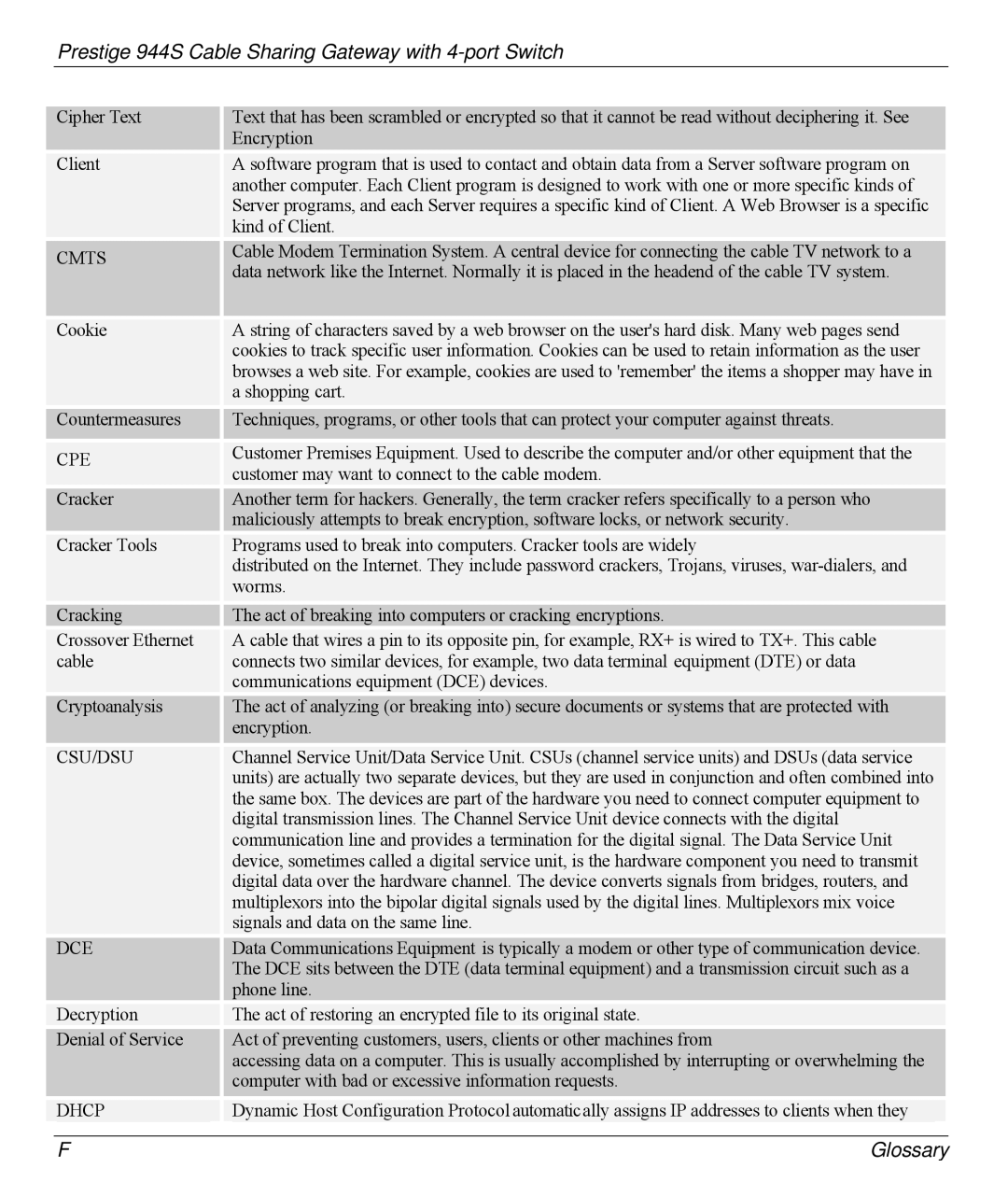
Prestige 944S Cable Sharing Gateway with 4-port Switch
Cipher Text
Client
CMTS
Cookie
Countermeasures
CPE
Cracker
Cracker Tools
Cracking Crossover Ethernet cable
Cryptoanalysis
Text that has been scrambled or encrypted so that it cannot be read without deciphering it. See Encryption
A software program that is used to contact and obtain data from a Server software program on another computer. Each Client program is designed to work with one or more specific kinds of Server programs, and each Server requires a specific kind of Client. A Web Browser is a specific kind of Client.
Cable Modem Termination System. A central device for connecting the cable TV network to a data network like the Internet. Normally it is placed in the headend of the cable TV system.
A string of characters saved by a web browser on the user's hard disk. Many web pages send cookies to track specific user information. Cookies can be used to retain information as the user browses a web site. For example, cookies are used to 'remember' the items a shopper may have in a shopping cart.
Techniques, programs, or other tools that can protect your computer against threats.
Customer Premises Equipment. Used to describe the computer and/or other equipment that the customer may want to connect to the cable modem.
Another term for hackers. Generally, the term cracker refers specifically to a person who maliciously attempts to break encryption, software locks, or network security.
Programs used to break into computers. Cracker tools are widely
distributed on the Internet. They include password crackers, Trojans, viruses,
The act of breaking into computers or cracking encryptions.
A cable that wires a pin to its opposite pin, for example, RX+ is wired to TX+. This cable connects two similar devices, for example, two data terminal equipment (DTE) or data communications equipment (DCE) devices.
The act of analyzing (or breaking into) secure documents or systems that are protected with encryption.
CSU/DSU |
| Channel Service Unit/Data Service Unit. CSUs (channel service units) and DSUs (data service |
|
| units) are actually two separate devices, but they are used in conjunction and often combined into |
|
| the same box. The devices are part of the hardware you need to connect computer equipment to |
|
| digital transmission lines. The Channel Service Unit device connects with the digital |
|
| communication line and provides a termination for the digital signal. The Data Service Unit |
|
| device, sometimes called a digital service unit, is the hardware component you need to transmit |
|
| digital data over the hardware channel. The device converts signals from bridges, routers, and |
|
| multiplexors into the bipolar digital signals used by the digital lines. Multiplexors mix voice |
|
| signals and data on the same line. |
|
|
|
DCE |
| Data Communications Equipment is typically a modem or other type of communication device. |
|
| The DCE sits between the DTE (data terminal equipment) and a transmission circuit such as a |
|
| phone line. |
|
|
|
Decryption |
| The act of restoring an encrypted file to its original state. |
|
|
|
Denial of Service |
| Act of preventing customers, users, clients or other machines from |
|
| accessing data on a computer. This is usually accomplished by interrupting or overwhelming the |
|
| computer with bad or excessive information requests. |
|
|
|
DHCP |
| Dynamic Host Configuration Protocol automatically assigns IP addresses to clients when they |
F | Glossary |
